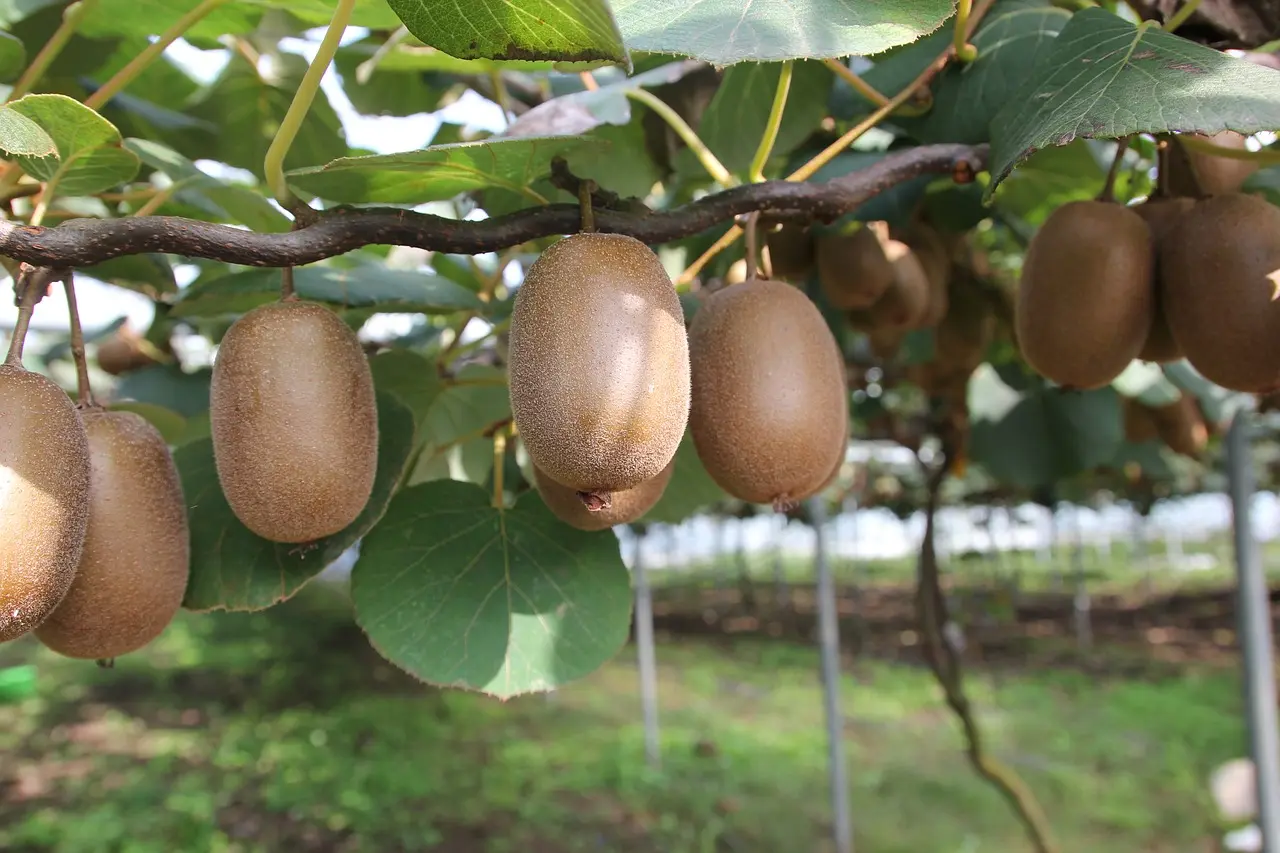How to Grow Kiwi Fruit Plant: Growing, Care & Harvest Tips
Written by Ivy
Dec 10 2021
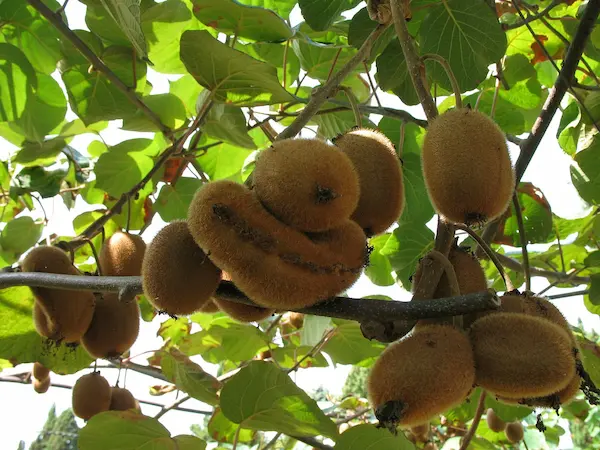
Kiwi plant is a rapidly growing perennial vining plant that produces delicious, bright green fruit. If not pruned and trained, the vines will grow up trees. Kiwi fruit is known as the "king of fruits" because its vitamin C content is among the best in fruits. Kiwi fruit also contains good soluble dietary fiber. In addition to high nutritional value and medical care, it also has high economic value. How to grow your own Kiwi Fruit Plant scientifically? First, the key points of Kiwi vine growing are introduced as follows for reference.
As Kiwi fruit plant is very sensitive to temperature and humidity, it must be noted that during the planting period, the annual average temperature can only be maintained between 11 ℃ and 17 ℃. Therefore, the planting time must not be in summer. Generally, the planting time is the most appropriate from February to march in spring. If planting more than one, space them 3–4.5m (10–15ft) apart (although a male should be positioned closer, only 60cm/2ft away from the female). Follow the steps of growing kiwi vine plant.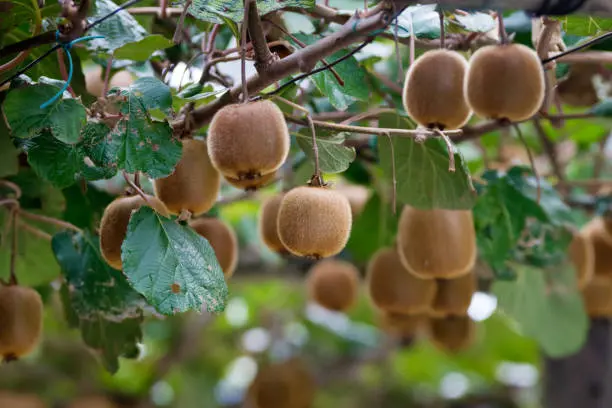
In the early spring, the rain season comes early and rains frequently. We should choose the cloudy day before the rain or the sunny day after the spring rain for fixed planting of Kiwi plants. If we choose to plant in wet and muddy weather like rain or after rain, the root development of Kiwi fruit seedlings will be slow and the quality will be very poor, which will seriously affect the survival probability of Kiwi trees. At the same time, such weather is also very unfavorable to our field operation. In general, it's best not to plant seedlings whose roots have matured or branches have grown to a certain extent. The survival rate of such Kiwi plants is very low.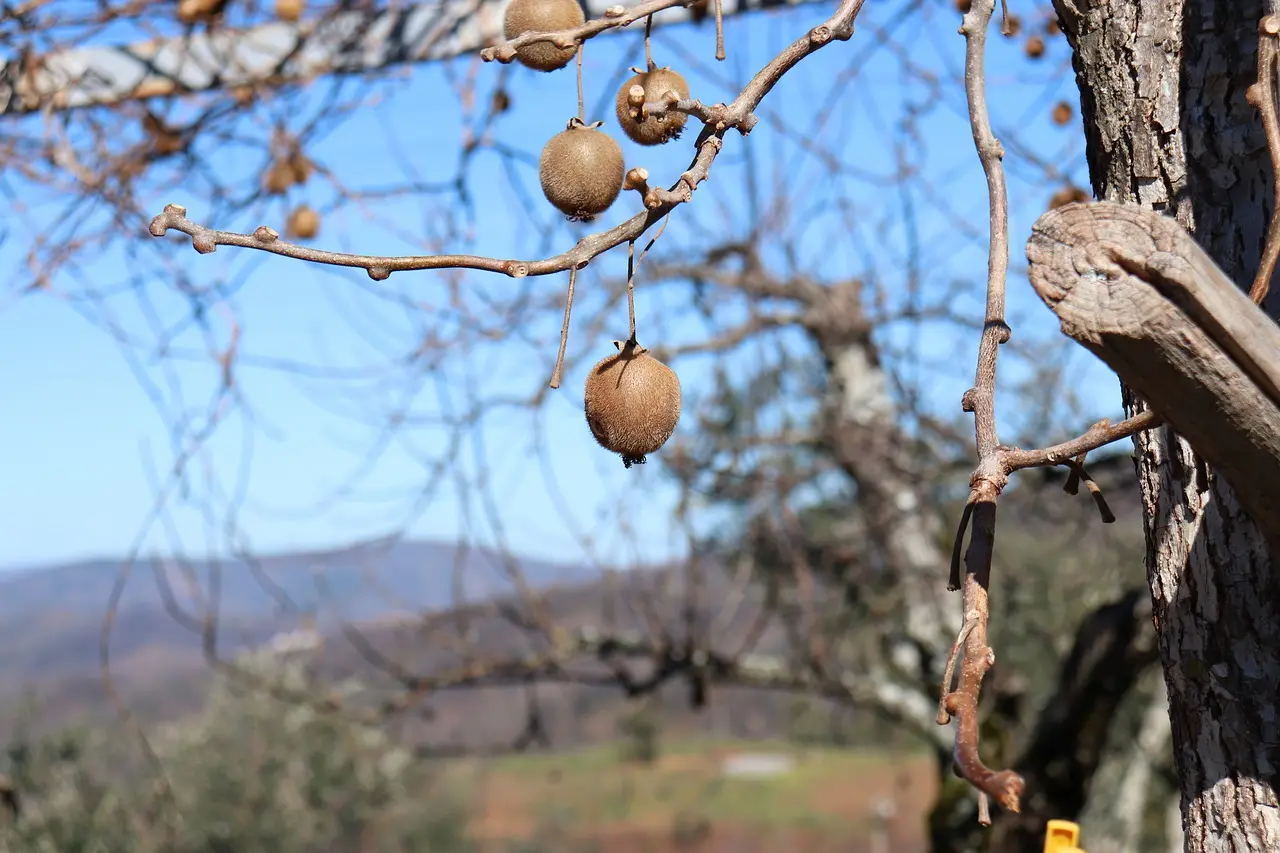
In many orchards, there are a large number of unexplained dead trees in summer and autumn. In fact, the trees are watered, soaked and drowned. Kiwi fruit plant will never die of drought, only waterlogging. Many fruit farmers have experience. In summer, if there is continuous rainfall, or if there is rainfall just after watering the ground, once the weather turns sunny, the temperature will rise quickly, and many Kiwi trees will wither immediately (commonly known as next noon). If they are not handled in time, Kiwi fruit plant will soon die. This is Kiwi fruit plant's typical love of water and fear of waterlogging.
Kiwi fruit plant has dense branches and leaves, shallow root distribution, and is neither drought resistant nor flood resistant. Therefore, kiwi fruit garden needs irrigation and drainage equipment, such as irrigation ditch, drainage ditch, drip irrigation, sprinkler irrigation equipment, etc. The economic water for Kiwi fruit plant irrigation is drip irrigation, and the water supply is uniform; Sprinkler irrigation uses a large amount of water, but it also plays a great role. In addition to supplying the water required by the root system in summer, sprinkler irrigation also increases the air humidity and reduces the tree temperature. Sprinkler irrigation can prevent freezing in early spring, autumn and winter.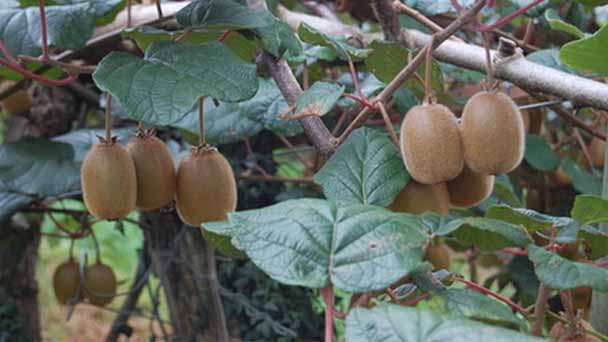
Kiwi fruit plant is a vine. We must erect strong and durable scaffolds immediately after planting to facilitate its growth and fruit. Kiwifruit planting mainly adopts T-shaped frame, fence frame, triangular frame, greenhouse frame, etc. The flat roof greenhouse frame is mostly used, and the original small-diameter trees can be used as live piles locally, plus some replaceable bamboo and wood dirt. We need to use concrete piles at the key parts of Kiwi tree. The local frame height is 1.8m, and the 10-12 iron wire is vertically and horizontally crossed to form a "well" shaped network, with a spacing of about 60cm.
We can apply germinating fertilizer once from the end of February to the beginning of March. First loosen the soil around the kiwi tree tray, then spread it, and then turn it deep into the soil; Strip application can also be adopted, with a general ditch depth of about 20cm, and fertilizer and soil can be applied. Kiwi tree applies 0.1kg urea per plant. Apply flower and fruit protection fertilizer + guaguozhuangdiling respectively before flowering, young fruit stage and fruit expansion stage of kiwi fruit to meet the physiological needs of fruit development, prevent Kiwi fruit plant from weak flowers or falling flowers and fruits, improve the fruit expansion speed, strengthen fruits and increase color.
Kiwi fruit plant is applied with organic fertilizer and chemical fertilizers such as quick acting nitrogen fertilizer before falling leaves from October to November after fruit picking. The application amount of base fertilizer in Kiwi fruit plant accounts for 60% of the annual fertilization amount. Usually for young trees, 50 kg of rotten manure is applied to each plant, plus 0.25 kg of calcium superphosphate and 0.25 kg of potassium chloride. For adult fruit trees, apply 50-80kg rotten manure, 1kg calcium superphosphate and 0.2-0.5kg potassium chloride, or 1kg compound fertilizer to each plant.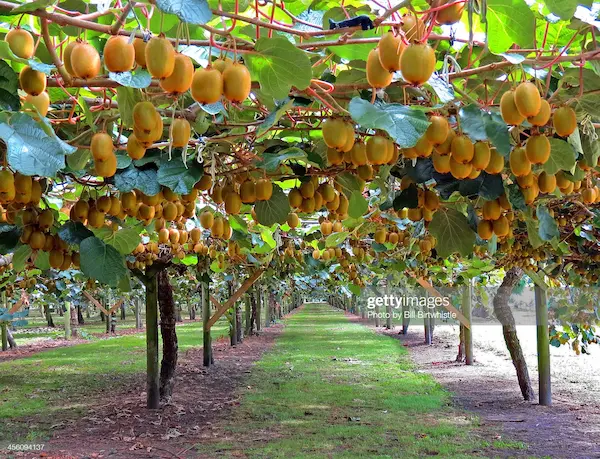
The above is the basic application means of how to Kiwi fruit plant Pruning, so we must see many details. Sometimes the success and failure are in a small detail. As long as we pay attention to the above steps and details, we can greatly improve the survival rate of Kiwi fruit plant. In summer, gently remove the skin of Kiwi tree fruit and take a bite. The instant cool pleasure makes the hot summer no longer boring. On the contrary, people will enjoy the feeling of collision between the hot summer and the cool kiwi fruit. Well, do you look forward to planting Kiwi vine like me?
We apply organic fertilizer to Kiwi fruit plant mainly from cow manure, pig manure and garbage fertilizer. Before fertilizing, heap retting method shall be adopted to make it fully decomposed and achieve balanced fertilization. After fertilizing Kiwi tree, we also need to cover it with a layer of soil to prevent rainwater from washing away the fertilizer. The application of accelerating fertilizer is conducive to the flowering of buds and promotes the growth of new shoots. It is best to apply accelerating fertilizer before germination, mainly based on available nitrogen fertilizer and applied throughout the garden. Promote the application of fruit fertilizer after flowering can promote the rapid growth of fruits, preferably 20 to 25 days after falling flowers. We can apply some strong fertilizer to kiwi tree, which can enrich the interior of the fruit, increase the weight of the fruit and improve the quality.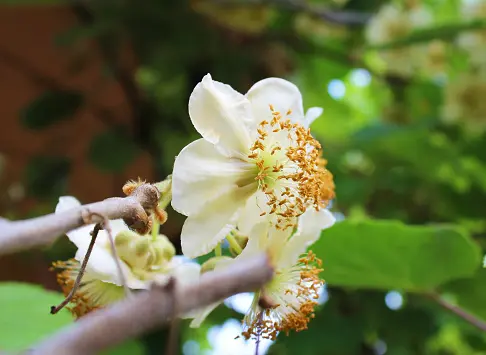
Male Kiwi Fruit FlowerIn order for the kiwi plant to set fruit, both male and female kiwi vines are necessary. If you're planning to grow a mini kiwi plant that is not self-fertile, choose at least one male (non-fruiting) variety to pollinate up to eight female plants. In almost all situations a self-fertile variety is best because they can be grown as single plants, varieties that are not self-fertile are notoriously difficult to pollinate because the flowers are not very attractive to bees.
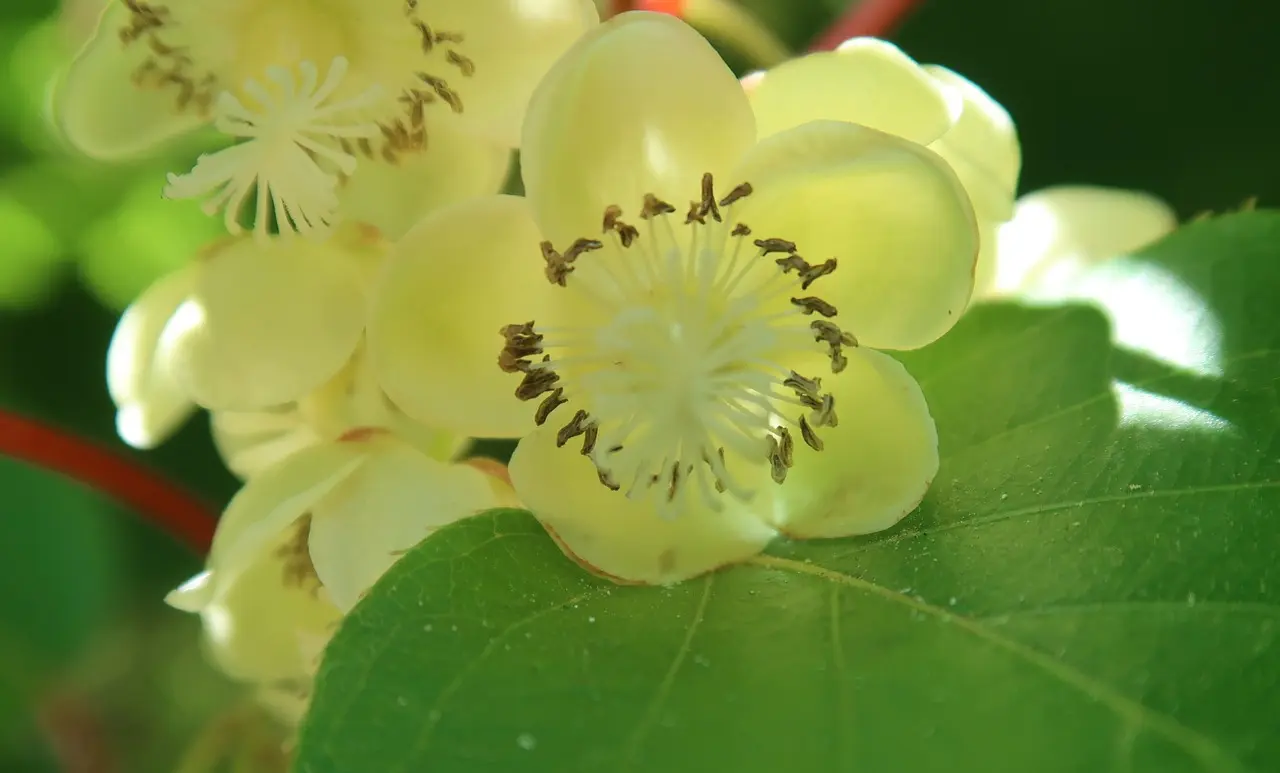
Female Kiwi Fruit FlowerFemale kiwi plant flowers are with long sticky stigmas radiating out from the center of the bloom. The female variety flower will also have bright white, well-defined ovaries at the base which male flowers do not, which are the parts that develop into kiwi fruit. Male kiwi flowers have a brilliantly colored yellow center due to their pollen-bearing anthers. Since the male kiwi vines do not bear fruit, they put all of their energy into vine growth and are, thus, often more vigorous and larger than their female counterparts.
Carefully pick kiwi fruit from the vine by snapping them off their stalks, being not to bruise the fruits when picking. The fruits that are not fully ripe are hard but will soften and sweeten in a week or two at room temperature. If you store your harvested kiwi fruit in a pierced plastic bag in a fridge, they can keep for up to three months.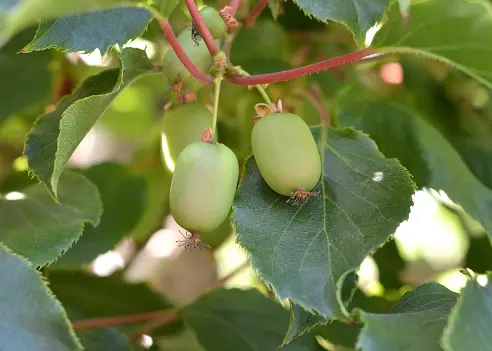
Read Next:
Best Fruits -19 Fruits That Can Improve Your Health
8 Best Winter Fruits and Their Benefit
Kiwi Fruit Plant Quick InfoWhen to Grow Kiwi Fruit PlantWhere to Grow Kiwi Fruit PlantHow to Grow Kiwi Vine Plant in Garden (Steps)How to Propagate Kiwi Fruit PlantGrowing Kiwi Fruit Plant from CuttingGrowing Kiwi Fruit Plant from DivisionHow to Care for Kiwi Fruit PlantKiwi Fruit Plant WateringSoil for Kiwi Fruit PlantKiwi Fruit Plant Light RequirementsKiwi Fruit Plant Temperature CareKiwi Fruit Plant Humidity RequirementsFertilizer for Kiwi Fruit PlantPruning Kiwi Fruit PlantRepotting Kiwi Fruit PlantKiwi Fruit Plant Pest & Disease ControlIdentify Male and Female Kiwi Plant from FlowersWhen to Harvest Kiwi FruitKiwi Fruit VarietiesHardy Kiwis Fuzzy Kiwis Arctic Kiwi
Kiwi Fruit Plant Quick Info
| Botanical/Scientific Name | Actinidia deliciosa |
| Common Name | Kiwi Vine, Kiwi Tree, Kiwi Fruit, Kiwi Fruit Plant |
| Varieties | Actinidia arguta, the Hardy kiwi, Actinidia Deliciosa, Fuzzy kiwi |
| Kiwi Fruit Uses | Helps treat asthma; Aids digestion; Boosts immune system; Helps prevent sickness; Manages blood pressure;Reduces blood clotting; Protects against vision loss; Potential risks |
| Origin | Mainland China and Taiwan |
| Light Care | Full sun with well drained soil |
| Soil Care | Fertile, well-drained, slightly acid soil |
| Temperature Care | 60-75 degrees |
| Humidity Care | Moisture Humidity |
| Watering | Four times a week during summer |
| Pruning Care | Remove all side branches until the vine reaches the top of the post |
| Fertilizer Care | Fertilize in early March |
| Propagation | Grafting fruiting varieties onto rootstock or by rooting kiwi cuttings |
| Toxic | Some people who are allergic to kiwi |
When to Grow Kiwi Fruit Plant
Kiwi fruit plants are best planted in spring as the soil and weather warm up after the threat of frost has passed. Kiwi plants typically begin bearing fruit 3 to 5 years after planting.Where to Grow Kiwi Fruit Plant
Kiwi fruit not only contains rich nutrition, but also has a pleasant shape. All these external conditions have brought rich economic value to kiwi plants, so Kiwi plant has also become the preferred project for planting. When planting Kiwi tree, we must choose to build gardens in places with convenient transportation, pay attention to the fertility and acidity of the soil, and we should choose to plant it in sandy loam with good drainage and exhaust. However, when planting Kiwi plants, one link can not be ignored is the construction of Kiwi plant zone.As Kiwi fruit plant is very sensitive to temperature and humidity, it must be noted that during the planting period, the annual average temperature can only be maintained between 11 ℃ and 17 ℃. Therefore, the planting time must not be in summer. Generally, the planting time is the most appropriate from February to march in spring. If planting more than one, space them 3–4.5m (10–15ft) apart (although a male should be positioned closer, only 60cm/2ft away from the female). Follow the steps of growing kiwi vine plant.

How to Grow Kiwi Vine Plant in Garden (Steps)
- Step 1: Buy a sturdy kiwi vine plant with lots of shoots at the base and roots reaching to the edge of the pot. Before you plant it, give it a good water.
- Step 2: Prepare your plant support in place before starting planting, whether it is wire, a trellis or mesh
- Step 3: Dig a hole 30-60cm (1-2ft) that's wider but only a little deeper than the pot. Break up hard soil with your spade and dig in some compost.
- Step 4: Take kiwi vine plant out of the pot. Tease out the roots before planting. Trim off rot roots or week leaves.
- Step 5: Plant your kiwi vine plant in the hole.
- Step 6: Refill the hole around the plant adding a feed and compact the soil, then water thoroughly around to keep the soil moist. Prevent weeds around.
- Step 7: Tie your vine plant shoots to the original canes, and fan these out until they reach your climbing support.
- Step 8: Care for kiwi vine plant regularly as it grows, guide or tie in the stray shoots to the support.
How to Propagate Kiwi Fruit Plant
Growing Kiwi Fruit Plant from Cutting
In fact, kiwi tree is the best choice for cutting propagation before the beginning of spring at the end of winter. It is suggested that kiwi tree should be planted 2-3 days before rain, because the survival rate of seedlings can be greatly improved in this case. The survival rate will be reduced to a certain extent if it is planted after sprouting and rooting. (Find more Winter Fruit here.)In the early spring, the rain season comes early and rains frequently. We should choose the cloudy day before the rain or the sunny day after the spring rain for fixed planting of Kiwi plants. If we choose to plant in wet and muddy weather like rain or after rain, the root development of Kiwi fruit seedlings will be slow and the quality will be very poor, which will seriously affect the survival probability of Kiwi trees. At the same time, such weather is also very unfavorable to our field operation. In general, it's best not to plant seedlings whose roots have matured or branches have grown to a certain extent. The survival rate of such Kiwi plants is very low.
Growing Kiwi Fruit Plant from Division
First of all, we should confirm the spacing of each row of seedlings: Kiwi fruit plant Division Propagation should be determined according to its type, selected land quality, geographical location, terrain level, quality of irrigation water source and different management methods. It can be planted sparsely in areas with more nutrients. Two rare places can be planted more intensively. We can also adjust the density according to the length, thickness and variety of Kiwi fruit plant. It is not good to grow kiwi fruit plant too intensively. In many areas, kiwi vine is planted too intensively, resulting in fruit displacement, weak branches and stems, dead inner bore branches and leaves, premature growth and aging of trees, which should be paid attention to when we plant Kiwi plant.
How to Care for Kiwi Fruit Plant
Kiwi fruit plant needs water but is afraid of waterlogging. Therefore, the requirements for soil moisture and air humidity are relatively strict, which determines that kiwi plant is most suitable for cultivation in areas with abundant rainfall, uniform distribution and high air temperature. The drought resistance of Kiwi tree is worse than that of ordinary fruit plant. Kiwi tree has relatively dense leaf shape, large transpiration and large demand for water. Insufficient water will easily cause Kiwi tree branches to grow slowly, leaves to sag and become smaller, and leaf edges to wither. During drought, the leaves begin to dry up. At this time, it is necessary to timely irrigate or spray water. Especially during the seedling period of Kiwi plant, its root system has not fully expanded, so it is more necessary to supplement sufficient water.Kiwi Fruit Plant Watering
Kiwi fruit plant likes water and is afraid of waterlogging. The main reason is that kiwi vine plant is a broad-leaved fruit tree. Especially in summer, the leaf transpiration is very strong and the water demand is relatively large. Therefore, it is generally required that the soil water content should be maintained at 70% in June, July and August. However, at the same time, the root system of Kiwi fruit plant is fleshy root with strong respiration and requires more oxygen content in the soil, In other words, it is necessary to have the necessary soil permeability. Therefore, according to the growth and decline of soil water and gas, it is not allowed to water too much. This is a very contradictory unity. What should we do? Therefore, we should grow grass on the ground, increase the application of organic fertilizer and strengthen the soil water storage capacity.In many orchards, there are a large number of unexplained dead trees in summer and autumn. In fact, the trees are watered, soaked and drowned. Kiwi fruit plant will never die of drought, only waterlogging. Many fruit farmers have experience. In summer, if there is continuous rainfall, or if there is rainfall just after watering the ground, once the weather turns sunny, the temperature will rise quickly, and many Kiwi trees will wither immediately (commonly known as next noon). If they are not handled in time, Kiwi fruit plant will soon die. This is Kiwi fruit plant's typical love of water and fear of waterlogging.
Kiwi fruit plant has dense branches and leaves, shallow root distribution, and is neither drought resistant nor flood resistant. Therefore, kiwi fruit garden needs irrigation and drainage equipment, such as irrigation ditch, drainage ditch, drip irrigation, sprinkler irrigation equipment, etc. The economic water for Kiwi fruit plant irrigation is drip irrigation, and the water supply is uniform; Sprinkler irrigation uses a large amount of water, but it also plays a great role. In addition to supplying the water required by the root system in summer, sprinkler irrigation also increases the air humidity and reduces the tree temperature. Sprinkler irrigation can prevent freezing in early spring, autumn and winter.
Soil for Kiwi Fruit Plant
We hereby suggest that Kiwi fruit plant should be planted in gully type pits. Before that, we should first determine the distance between each row, and then determine the distance between each seedling after completing the above operations. The second method is that we can dig round caves for Kiwi vine planting. The same as the above method, the operation must be carried out after determining the line spacing. Either of the above two methods must be completed one month before planting plants. In this way, we are conducive to the cultivation of soil. The first method is suitable for areas with relatively flat terrain, not for mountainous areas. The width of trench excavation is generally about 1.5m and the depth is about 1m. The length of Kiwi vine plant depends on the planting quantity. While the old Kiwi tree is flowering, the surface soil and bottom soil shall be stacked on both sides separately. After the excavation, we should fertilize each sapling. The basic fertilizers are divided into soil, miscellaneous fertilizer, animal manure, straw, weeds, quicklime and phosphate fertilizer. These fertilizers were mixed with the soil in layers and buried in the excavated trenches. When covering Kiwi vie plant with soil, we should put the previously excavated topsoil at the bottom of the ditch, and then put the soil excavated from the bottom to the upper half of the gully. Then, the surface of the trench shall be earthed and about 15 cm higher than the surface. After completing this work, we can re measure the distance of seedlings to be planted. (Find more healthy fruit here.)Kiwi Fruit Plant Light Requirements
When we pay attention to the illumination of Kiwi fruit plant, we can choose the mountainous area with convenient transportation, sufficient illumination, water source, moderate rainfall and slightly high humidity, loose and well ventilated sandy loam or sandy soil, or hilly and mountainous areas rich in humus as the best garden. After the Kiwi fruit plant site is determined, the roads, irrigation and drainage system and fertilizer management room shall be planned first, and then the ventilation ditch of the planting land shall be planned. Kiwi fruit plant is suitable for planting in hills and mountains with an altitude of 400 ~ 1200m. It should be within 10 ~ 15. Gardens are built on sloping hills and mountains. Kiwi trees can also be planted with greenhouse racks. We need to heavily trim Kiwi fruit plant in winter to renew and rejuvenate them in time. We also need to re-apply base fertilizer to kiwi tree, flood and fertilizer, timely irrigation, and avoid sudden dry and wet to prevent fruit cracking.Kiwi Fruit Plant Temperature Care
We should plant Kiwi tree from the end of winter to the beginning of spring, preferably two days before the rain, so that the soil is wetter and the survival rate of seedlings can be improved. Kiwi fruit plant has high requirements for climate and environment. It likes a warm environment with adequate light and is not resistant to cold. Kiwi tree will not bear fruit in low temperature environment. Therefore, when planting, it depends on whether the climate in the area can meet the growth needs. If not, do not plant, and there will be no results.
Kiwi Fruit Plant Humidity Requirements
Kiwi fruit plant likes to grow in warm and humid valleys. It requires relatively short sunshine time and is not very strict with the soil. When choosing Kiwi fruit plant garden, it is better to build the garden in the areas with sufficient light, water source, moderate rainfall and slightly high humidity, loose and well ventilated sandy loam or sandy soil or hilly and mountainous areas with loose soil rich in humus.Kiwi fruit plant is a vine. We must erect strong and durable scaffolds immediately after planting to facilitate its growth and fruit. Kiwifruit planting mainly adopts T-shaped frame, fence frame, triangular frame, greenhouse frame, etc. The flat roof greenhouse frame is mostly used, and the original small-diameter trees can be used as live piles locally, plus some replaceable bamboo and wood dirt. We need to use concrete piles at the key parts of Kiwi tree. The local frame height is 1.8m, and the 10-12 iron wire is vertically and horizontally crossed to form a "well" shaped network, with a spacing of about 60cm.
Fertilizer for Kiwi Fruit Plant
Kiwi tree is a perennial vine fruit tree that needs more fertilizer, so its important material basis of early fruit, high yield, stable yield, high quality and long life depends on reasonable fertilization.We can apply germinating fertilizer once from the end of February to the beginning of March. First loosen the soil around the kiwi tree tray, then spread it, and then turn it deep into the soil; Strip application can also be adopted, with a general ditch depth of about 20cm, and fertilizer and soil can be applied. Kiwi tree applies 0.1kg urea per plant. Apply flower and fruit protection fertilizer + guaguozhuangdiling respectively before flowering, young fruit stage and fruit expansion stage of kiwi fruit to meet the physiological needs of fruit development, prevent Kiwi fruit plant from weak flowers or falling flowers and fruits, improve the fruit expansion speed, strengthen fruits and increase color.
Kiwi fruit plant is applied with organic fertilizer and chemical fertilizers such as quick acting nitrogen fertilizer before falling leaves from October to November after fruit picking. The application amount of base fertilizer in Kiwi fruit plant accounts for 60% of the annual fertilization amount. Usually for young trees, 50 kg of rotten manure is applied to each plant, plus 0.25 kg of calcium superphosphate and 0.25 kg of potassium chloride. For adult fruit trees, apply 50-80kg rotten manure, 1kg calcium superphosphate and 0.2-0.5kg potassium chloride, or 1kg compound fertilizer to each plant.

Pruning Kiwi Fruit Plant
If the soil in the trenches or caves we dug before reaches the surface or is lower than the surface after settlement, we need to cultivate the soil of Kiwi fruit plant again. This time, we need to take care that the soil of Kiwi tree only needs to be about 10 cm higher than the surface. When carrying out the next work, we must pay attention to the distinction between male and female seedlings. One person digs a small pit for Kiwi fruit plant, and the other is responsible for putting Kiwi tree in the middle of the pit, stretching the root of the seedling by hand, then covering it with a layer of fine soil, and then gently tamping it by hand.The above is the basic application means of how to Kiwi fruit plant Pruning, so we must see many details. Sometimes the success and failure are in a small detail. As long as we pay attention to the above steps and details, we can greatly improve the survival rate of Kiwi fruit plant. In summer, gently remove the skin of Kiwi tree fruit and take a bite. The instant cool pleasure makes the hot summer no longer boring. On the contrary, people will enjoy the feeling of collision between the hot summer and the cool kiwi fruit. Well, do you look forward to planting Kiwi vine like me?
Repotting Kiwi Fruit Plant
The most suitable time for Kiwi fruit plant repotting is from 18 days to 22 days before bud germination. It mainly adopts the grafting method of single bud cutting. To select the grafting with fuller growth and smaller pith, you can cut the branch segment with one bud, which is about three to five centimeters long, and select the straight side to cut off the cortex, The best depth is to expose the xylem or the xylem with a slight band. Select the smooth side to cut the next knife. The length of the cutting surface is slightly longer than that of the connecting surface, and the depth is the same as that of the connecting surface. Kiwi fruit plant repotting requires that the size of the rootstock should be basically the same as that of the rootstock. It should be noted that the layers of the rootstock should be aligned, and then wrapped with plastic grafted film.We apply organic fertilizer to Kiwi fruit plant mainly from cow manure, pig manure and garbage fertilizer. Before fertilizing, heap retting method shall be adopted to make it fully decomposed and achieve balanced fertilization. After fertilizing Kiwi tree, we also need to cover it with a layer of soil to prevent rainwater from washing away the fertilizer. The application of accelerating fertilizer is conducive to the flowering of buds and promotes the growth of new shoots. It is best to apply accelerating fertilizer before germination, mainly based on available nitrogen fertilizer and applied throughout the garden. Promote the application of fruit fertilizer after flowering can promote the rapid growth of fruits, preferably 20 to 25 days after falling flowers. We can apply some strong fertilizer to kiwi tree, which can enrich the interior of the fruit, increase the weight of the fruit and improve the quality.
Kiwi Fruit Plant Pest & Disease Control
The main diseases of Kiwi vine plants are anthrax and brown spot. The pests of Kiwi tree are flower bud maggots, beetles and fruit-sucking night moths. It is necessary to strengthen the management of orchards, enhance the vigor of trees and strengthen the disinfection of soil, mainly focusing on prevention.Identify Male and Female Kiwi Plant from Flowers

Male Kiwi Fruit Flower

Female Kiwi Fruit Flower
When to Harvest Kiwi Fruit
Kiwi Plants usually start fruiting three or four years after planting. Kiwi fruits need a very warm, long summer and autumn to ripen outdoors. Kiwi fruit tastes better if they ripen away from the plant or tree, rather than on the vine. Generally, the fruits may take several weeks to ripen. Usually, you can harvest your kiwi fruits around early autumn and certainly before the first frost, before it is fully ripe.Carefully pick kiwi fruit from the vine by snapping them off their stalks, being not to bruise the fruits when picking. The fruits that are not fully ripe are hard but will soften and sweeten in a week or two at room temperature. If you store your harvested kiwi fruit in a pierced plastic bag in a fridge, they can keep for up to three months.
Kiwi Fruit Varieties
Hardy Kiwis
This kind of Kiwi Fruit Varieties are one of the newer vines developed for cooler season growing. These kiwi vine plant varieties are perfect for regions with light frosts and short growing seasons, such as the Pacific Northwest. They are hairless, green and small but pack a lot of flavor and are tolerant of conditions that the fuzzy kiwi cannot withstand.
Fuzzy Kiwis
This kind of Kiwi Fruit Varieties is the most common kiwi found in grocery stores. It is only hardy in areas with mild winters.Arctic Kiwi
This kind of Kiwi Fruit Varieties is the most cold tolerant of the different varieties of kiwi. It has extremely hardy fruit and pink and white variegation on the leaves, making it an attractive addition to the landscape. Fruits are smaller and sparser than the other kiwi vining plant varieties but sweet and delicious. Krupnopladnaya has the largest fruit and Pautske is the most vigorous of the Arctic kiwis. Each of these does need male pollinators to produce fruit.Read Next:
Best Fruits -19 Fruits That Can Improve Your Health
8 Best Winter Fruits and Their Benefit
Latest Updated
- Benefits of Bugleweed - 7 Science-backed Health Benefits
- Bugleweed Dangers & Side Effects - Is It Poisonous?
- How to Plant Evergreen Trees - What You Should Know
- When to Plant Evergreens - Grow Guide for Evergreen Trees
- 12 Wonderful Evergreen Shrubs for Your Garden
- 12 Popular Evergreen Plants with Pictures for Beginners
- When And How To Prune A Lilac Bush Like a Pro
- How to Grow & Care for Lilac Vine (Hardenbergia Violacea)
- Japanese Lilac Tree (Syringa Reticulata) Care & Propagation Guide
- Shumard Oak Pros and Cons - What to Know
Popular Articles
- Winter maintenance of Antirrhinum Majus
- How to Grow Terminalia Mantaly Tree
- How to Grow and Care for Crossostephium Chinense
- How to grow Antirrhinum Majus in spring
- Peristeria Elata (Dove Orchid) Profile: Info & Care Guide
- Underwatered Snake Plant (Sansevieria Trifasciata) - Signs And How To Fix
- How to Care for Brazilian Jasmine Plant (Mandevilla Sanderi)
- How to Grow & Care for Graptopetalum Purple Delight in Summer
- Rosa Chinensis (China Rose): Plant Growing & Care Tips
- How to Care for Baby Sun Rose (Aptenia Cordifolia)
